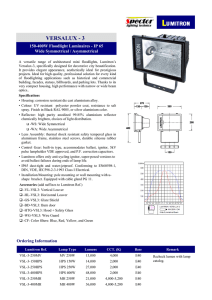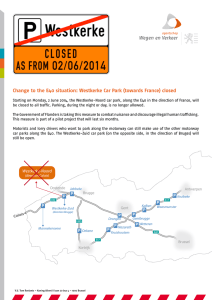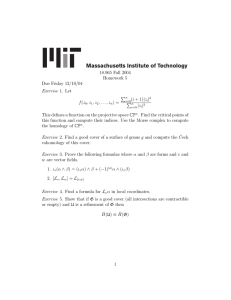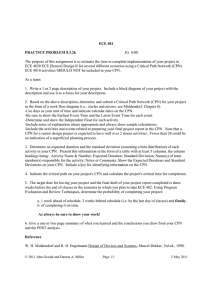Sportlight™ - GE Lighting
advertisement
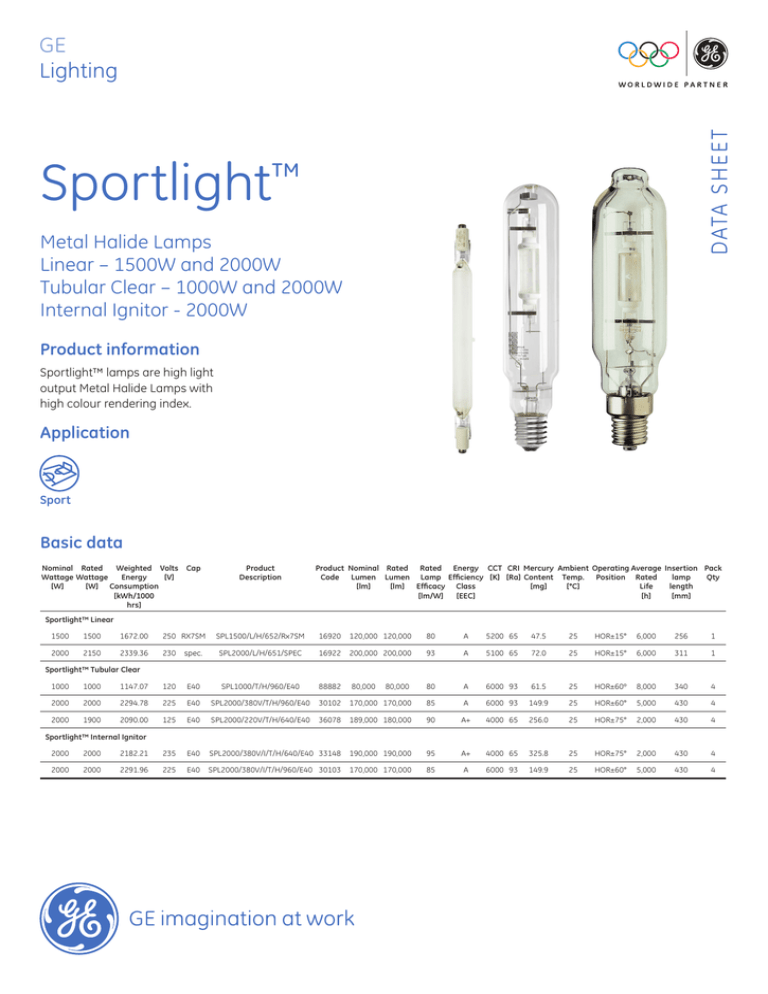
DATA SH EE T GE Lighting Sportlight™ Metal Halide Lamps Linear – 1500W and 2000W Tubular Clear – 1000W and 2000W Internal Ignitor - 2000W Product information Sportlight™ lamps are high light output Metal Halide Lamps with high colour rendering index. Application Sport Basic data Nominal Rated Weighted Volts Cap Wattage Wattage Energy [V] [W] [W] Consumption [kWh/1000 hrs] Product Description Product Nominal Rated Rated Energy CCT CRI Mercury Ambient Operating Average Insertion Pack Code Lumen Lumen Lamp Efficiency [K] [Ra] Content Temp. Position Rated lamp Qty [lm] [lm] Efficacy Class [mg] [°C] Life length [lm/W] [EEC] [h] [mm] Sportlight™ Linear 1500 1500 1672.00 250 RX7SM SPL1500/L/H/652/Rx7SM 16920 120,000 120,000 80 A 5200 65 47.5 25 HOR±15° 6,000 256 1 2000 2150 2339.36 230 spec. SPL2000/L/H/651/SPEC 16922 200,000 200,000 93 A 5100 65 72.0 25 HOR±15° 6,000 311 1 88882 80,000 80 A 6000 93 61.5 25 HOR±60º 8,000 340 4 Sportlight™ Tubular Clear 1000 1000 1147.07 120 E40 SPL1000/T/H/960/E40 80,000 2000 2000 2294.78 225 E40 SPL2000/380V/T/H/960/E40 30102 170,000 170,000 85 A 6000 93 149.9 25 HOR±60° 5,000 430 4 2000 1900 2090.00 125 E40 SPL2000/220V/T/H/640/E40 36078 189,000 180,000 90 A+ 4000 65 256.0 25 HOR±75° 2,000 430 4 Sportlight™ Internal Ignitor 2000 2000 2182.21 235 E40 SPL2000/380V/I/T/H/640/E40 33148 190,000 190,000 95 A+ 4000 65 325.8 25 HOR±75° 2,000 430 4 2000 2000 2291.96 225 E40 SPL2000/380V/I/T/H/960/E40 30103 170,000 170,000 85 A 6000 93 149.9 25 HOR±60° 5,000 430 4 Dimensions Figure 1. Figure 2. Figure 3. Figure 4. B B B A Type SPL1500/L/H/652/Rx7SM A A Wattage (W) A Contact Length [mm] B Contact Diameter [mm] C LCL [mm] Cap Bulb Glass Operating Position Fig. No. Minimum Starting Temperature [°C] 1500 250.7 24.3 N/A RX7SM Quartz Hor. ±15° 2 -30 SPL2000/L/H/651 spec 2000 310 26 N/A Spec Quartz Hor. ±15° 3 -30 SPL1000/T/H/960/E40 1000 333.5 65 229 E40 Hard glass Hor. ±60° 4 -20 SPL2000/380V/T/H/960/E40 2000 430 101.5 265 E40 Hard glass Hor. ±60° 1 -20 SPL2000/220V/T/H/640/E40 2000 430 101.5 287 E40 Hard glass Hor. ±75° 1 -20 SPL2000/380V/I/T/H/640/E40 2000 430 101.5 265 E40 Hard glass Hor. ±75° 1 -20 SPL2000/380V/I/T/H/960/E40 2000 430 101.5 265 E40 Hard glass Hor. ±60° 1 -20 Survival rate and lumen maintenance Lumen maintenance and survival rate 100% 80% % of initial The graph shows the survival of representative groups of lamps operated under control conditions at 10 hours per start. Lamp life in service will be affected by a number of parameters, such as mains voltage deviations, switching cycle, luminaire design and control gear. The information given is intended to be a practical guide in determining lamp replacement schedules. 60% 40% Lamp survival 1000W lumens 1500-2000W lumens 20% 0% 0 10% 20% Burning time Electrical data Data is based on a nominal lamp operating from a nominal choke (reactor) ballast. Product Description Lamp Voltage [V] Current [A] Power [W] Maximum Supply Current Voltage Crest Factor [V] SPL1500/L/H/652/Rx7SM 250 4.2 1000 1.8 380 SPL2000/L/H/651 Spec 230 10.3 2000 1.8 380 SPL1000/T/H/960/E40 120 9.5 1000 1.8 220 SPL2000/380V/T/H/960/E40 225 10.3 2000 1.8 380 SPL2000/220V/T/H/640/E40 125 16.5 2000 1.8 220 SPL2000/380V/I/T/H/640/E40 235 8.8 2000 1.8 380 SPL2000/380V/I/T/H/960/E40 225 10.3 2000 1.8 380 Note: For ballast characteristics please see page 4. 2 30% 40% 50% Spectral power distribution 5200K spectral power distribution 6000K spectral power distribution 50 40 40 40 30 20 30 20 10 10 0 Relative intensity 50 Relative intensity Relative intensity 4000K spectral power distribution 50 400 500 600 700 nm 30 20 10 0 400 500 600 700 nm 0 400 500 Wavelength Wavelength 600 700 nm Wavelength Operating note Metal halide lamps operate with a high internal pressure and there is a slight risk that lamps may shatter, particularly if run beyond rated life. At end of life a switch off should be introduced every 24 hours to reduce the risk of shattering. The lamp must be fully enclosed by a luminaire to ensure the retention of any fragments in the event of such failure. Run-up characteristics Wattage (w) Run-Up Time (mins) 1000-2000 4 Hot re-strike time All ratings re-strike within 16 minutes following a short interruption in the supply. Actual re-strike time is determined by ignitor type, pulse voltage and cooling rate of the lamp. Typical run-up characteristics 120 110 Percentage of final value The graph shows typical run-up characteristics for Sportlight™ lamps. Time for the light output to reach 90% of the final value is determined by supply voltage and ballast design. Typical value is: 100 90 80 70 60 Lamp current Supply current Supply power Lamp power Lamp Volt age Light output 50 40 30 20 10 0 0 3 6 9 Time from switch-on (minutes) Supply voltage Lamps are suitable for supplies in the range 380V to 420V 50/60Hz for appropriately rated series choke (reactor) ballasts. Lamps start and operate at 10% below the rated supply voltage when the correct control gear is used. However, in order to maximise lamp survival, lumen maintenance and colour uniformity the supply voltage and ballast design voltage should be within ±3%. Supply variations of ±5% are permissible for short periods only. This may be achieved by measuring mean supply voltage at the installation and selecting ballasts with appropriate settings. Control gear There are no international standards for metal halide lamps Typical superimposed ignitor circuit of this type. It is therefore important to check the compatibility of lamp and control gear. Detailed information is given BALLAST under “Guidance for luminaire manufacturers” overleaf. It is PHASE essential to use a ballast appropriate to the supply voltage at the luminaire. Typical wiring diagrams for control circuits incorporating “superimposed” ignitor and choke (reactor) ballast PFC Capacitor are shown. Refer to actual choke and ignitor manufacturers B data for terminal identification and wiring information. IGNITOR Lp N NEUTRAL 3 Fusing of circuits Cable between ignitor and lamp For a very short period after switch-on, all discharge lamps may act as a partial rectifier and as a result the ballast may allow several times the normal supply current to flow. For further information refer to the publication “Fuse Ratings for Discharge Lamps” available from GE Lighting. To achieve good starting superimposed ignitors must be adjacent to the luminaire. Cable capacitance of wiring between the ignitor“Lp” terminal and the lamp should not exceed 100pF (<1 metre length) when measured to adjacent earthed metal and/or other cables, unless otherwise stated by the ignitor manufacturer. Lamp operating temperature limits Ignitors Maximum cap temperature: 250°C Maximum bulb temperature: 550°C Control gear To achieve correct lamp starting, performance and life it is important that lamp and control gear are compatible and suitably rated for the supply voltage at the luminaire. Ballasts Ballasts should comply with specifications IEC61347-1 and IEC60923. Series choke (reactor) ballasts should have characteristics close to the following values: Current [A] Supply Voltage [V] Impedance [V/A] SPL1500/L/H/652/Rx7SM 6.8 380 34.4 SPL2000/L/H/651 spec 10.3 380 25.6 SPL1000/T/H/960/E40 9.5 220 17 SPL2000/380V/T/H/940/E40 10.3 380 25.5 SPL2000/220V/T/H/640/E40 16.5 220 9.25 SPL2000/380V/I/T/H/640/E40 8.8 380 28 SPL2000/380V/I/T/H/960/E40 10.3 380 25.5 Product Description Ballast thermal protection — use of ballasts incorporating thermal cut-out is not a specific requirement but is a good optional safety measure for the installation. Superimposed type ignitors are suitable. It is recommended that only GE approved ignitors are used. Ignitors should comply with specifications IEC61347-2 and IEC60927 and have starting pulse characteristics as follows: Product Description Voltage Voltage Width Repetition Current [V]1 [V]2 [µs]3 Rate 4 [A] SPL1500/L/H/652/Rx7SM 4,000 5,500 1 1-6/cycle 0.2 SPL2000/L/H/651/Spec 4,000 5,500 1 1-6/cycle 0.2 SPL1000/T/H/960/E40 4,000 5,000 1 1/cycle 0.2 SPL2000/380V/T/H/960/E40 4,000 5,000 1 1/half cycle 0.2 SPL2000/220V/T/H/640/E40 4,000 5,000 1 1/cycle 0.2 1. When loaded with 100 pF 2. When loaded with 20pF 3. At 90% peak voltage 4. From ignitorinto lamp during starting Pulse Phase Angle: 60-90°el and/or 240-270° el. Timed Ignitors—Use of a “timed” or “cut-out” ignitor is not a specific requirement but it is a good optional safety feature for the installation. The timed period must be adequate to allow lamps to cool and restart when the supply is interrupted briefly (see “Hot Re-strike Time”). A period of 5 minutes continuous or intermittent operation is recommended before the ignitor is automatically switched off. Commercially available 10/11 minute timed ignitors are suitable. Ballast voltage adjustment — series choke (reactor) ballasts incorporating additional tappings at ±20V of the rated supply voltage are recommended. Alternatively a single additional tapping 20V above the rated supply voltage will ensure lamps are not overloaded due to excessive supply voltage. PFC capacitors for choke (reactor) circuits Power factor correction is advisable in order to minimise supply current and electricity costs. www.gelighting.com/eu and General Electric are both registered trademarks of the General Electric Company GE Lighting is constantly developing and improving its products. For this reason, all product descriptions in this brochure are intended as a general guide, and we may change specifications from time to time in the interest of product development, without prior notification or public announcement. All descriptions in this publication present only general particulars of the goods to which they refer and shall not form part of any contract. Data in this guide has been obtained in controlled experimental conditions. However, GE Lighting cannot accept any liability arising from the reliance on such data to the extent permitted. Sportlight™ Data Sheet – July 2013
